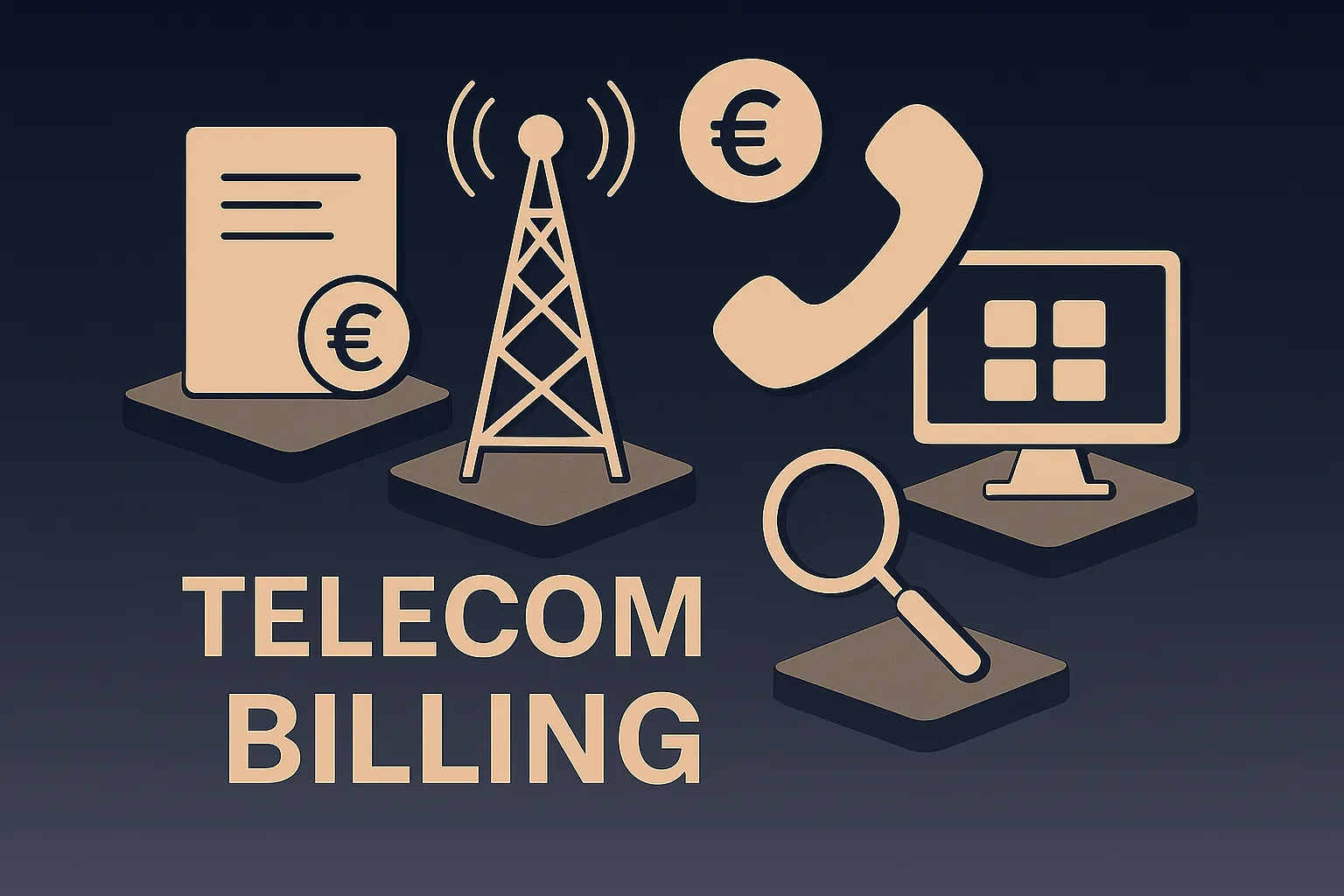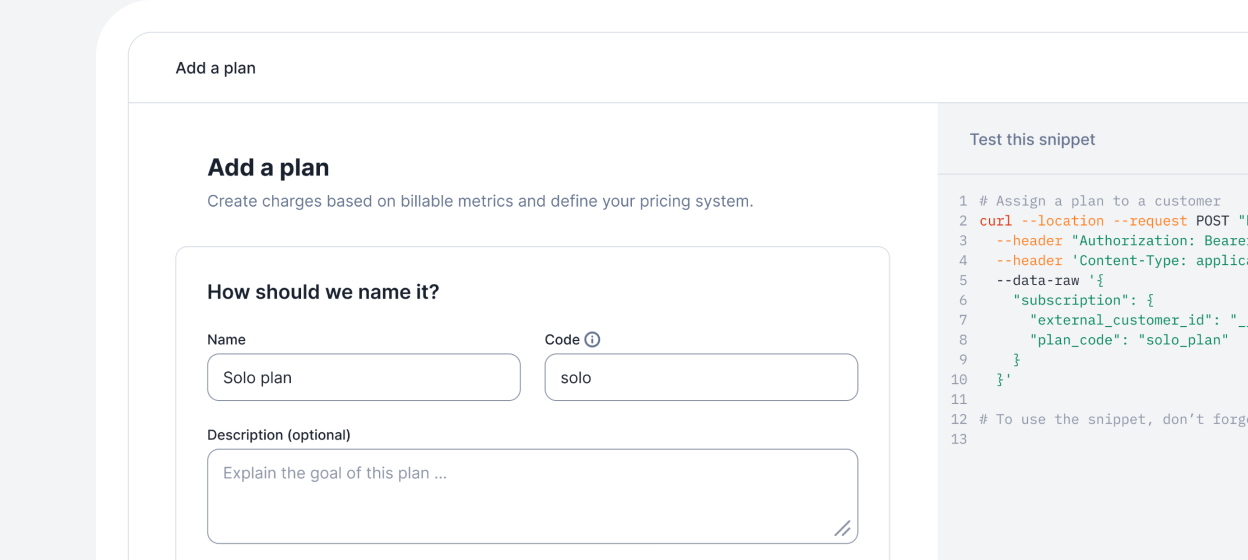Telecom billing: Best practices and systems to use

Modern telecommunications monetization hinges on three pillars: standards-aligned real-time charging (5G CCS), product-catalog-driven pricing exposed via open APIs, and bulletproof financial/assurance controls across retail, wholesale, and partner ecosystems. The combined OSS and BSS market will be worth $70 billion by 2025 [1], with operators implementing 3GPP-compliant converged charging and TM Forum Open APIs best positioned to price creatively, launch faster, and keep leakage/fraud in check.
The state of telco monetization in 2025
5G shifted charging from Diameter OCS to a Converged Charging System (CCS) with a Charging Function (CHF) in the 5G core. CCS unifies online/offline charging and enables monetization of slicing, edge, and IoT with service-based interfaces. The telecom billing software market is projected to grow from $32.64 billion in 2025 to $55.72 billion by 2034, exhibiting a 6.12% CAGR [2].
Simultaneously, telcos are commercializing network APIs through the GSMA Open Gateway initiative, creating new B2B pricing surfaces beyond connectivity. Wholesale roaming is migrating from TAP files toward BCE (Billing & Charging Evolution) to support 5G/IoT settlement models in near-real time. Fraud pressure remains high: global telecom fraud losses were estimated at $38.95 billion (≈2.5% of revenues) in 2023 [3].
Pricing models that work for telco
Core connectivity and usage models
- Tiered, flat-rate, and shared-allowance bundles with real-time spend controls
- Quality-based and slice-aware pricing for 5G SA networks
- Consumption-based models for data services with dynamic tier progression
- Hybrid subscription-usage combinations for premium service tiers
Enterprise and IoT constructs
- Device-class pricing for IoT ecosystems with differentiated connectivity rates
- Aggregated billing across enterprise locations with consolidated invoicing
- SLA-linked charges with automatic service credits for performance failures
- Capacity commits with periodic spending minimums and overage protection
Digital service monetization
- Event/API monetization through GSMA Open Gateway
- Network-as-a-Service billing for private 5G deployments
- Edge computing resource-based charging models
- Value-based pricing for premium network services and guarantees
Modern usage-based billing systems must handle high-frequency events while maintaining pricing flexibility. Platforms capable of processing thousands of billing events per second—like advanced metering solutions—enable real-time monetization of 5G slicing and IoT services without compromising performance.
Reference architecture for pricing & billing
Core system components
- Product catalog & offers as the single source of truth (TMF620), feeding CPQ, ordering, CCS, and billing
- Converged Charging (CCS/CHF) for real-time rating/authorization in 5G networks
- Mediation/usage data platform to collect/normalize records across network domains
- Bill, invoicing, presentment, payments & dunning integrated with PCI DSS-aligned processing
- Wholesale & roaming settlement with TAP and BCE support for modern charging models
Integration and APIs
- Open APIs & ODA components for portability and ecosystem integration
- Revenue assurance engines with automated reconciliation and leakage detection
- Fraud management systems with real-time blocking and ML-based pattern recognition
- Tax calculation engines for multi-jurisdiction compliance and regulatory fees
Best practices for pricing & rating
Catalog-first governance
- Establish product catalog as authoritative pricing source with version control
- Implement automated pricing rule validation before production deployment
- Enable real-time price testing and rollback capabilities for rapid iteration
- Maintain comprehensive audit trails for regulatory compliance and dispute resolution
Real-time operations
- Deploy CCS for immediate authorization and spend control across all services
- Implement usage throttling to prevent bill shock and service abuse
- Enable real-time balance inquiries and proactive customer notifications
- Support instant plan changes with accurate proration and service continuity
API and ecosystem monetization
- Expose monetizable capabilities through GSMA Open Gateway APIs
- Implement flexible pricing models for developer and enterprise API consumption
- Provide self-service developer portals with transparent billing and usage analytics
- Enable rapid partnership billing for revenue sharing and white-label services
Best practices for billing operations & assurance
Data quality and mediation excellence
- Multi-tier validation frameworks with duplicate detection and hash-based CDR verification
- Automated data enrichment for geographic, temporal, and service classification
- Quality gates and exception handling before rating engine processing
- Real-time data normalization across diverse network elements and service types
Revenue assurance and fraud prevention
- Comprehensive leakage monitoring mapped to TM Forum KPIs with automated alerting
- Multi-source reconciliation between network usage records and billing amounts
- ML-powered fraud detection with behavioral analysis and anomaly identification
- Geographic and temporal validation for impossible usage scenario detection
Modern enterprise billing platforms enhance these capabilities through cloud-native architectures that can process up to 15,000 billing events per second while maintaining sub-second response times for real-time authorization queries.
Compliance and tax considerations
Data protection and privacy
- GDPR and CCPA/CPRA compliance with customer consent management and data portability
- Regional data residency requirements for customer billing information
- Access controls and audit logging for billing data security and compliance
- Data retention policies aligned with telecommunications regulations
Financial and regulatory compliance
- Multi-jurisdiction tax calculation for VAT, GST, and communications-specific taxes
- Regulatory fee management including USF, E911, and spectrum license fees
- Truth-in-billing standards compliance for FCC/Ofcom transparency requirements
- Revenue recognition integration with enterprise accounting and financial systems
Systems landscape and vendor considerations
Converged charging platforms
- MATRIXX Software: Cloud-native charging with real-time capabilities
- Ericsson Charging System: 5G-ready CCS with network function integration
- Nokia Charging: Comprehensive online/offline charging for all network generations
- Oracle Communications Billing: Enterprise-grade revenue management
Supporting infrastructure
- Mediation platforms: DigitalRoute MediationZone for usage data processing
- Revenue assurance: Subex ROC and TEOCO HELIX for comprehensive monitoring
- Tax calculation: Avalara AvaTax and CCH SureTax for communications compliance
- API management: Kong, Apigee, and MuleSoft for Open Gateway monetization
For organizations requiring flexible pricing models and rapid service deployment, Lago's open-source billing platform provides an alternative approach with support for all pricing models including subscriptions, usage-based billing, prepaid credits, and add-ons with automatic invoice generation.
Build vs. buy guidance
Strategic buy decisions
- Converged charging systems: Unless Tier-1 operator with extensive 5G engineering resources
- Mediation platforms: Complex domain expertise and carrier-grade reliability requirements
- Tax calculation engines: Specialized communications tax knowledge and regulatory updates
- Fraud detection systems: Advanced ML algorithms and industry threat intelligence
Selective build opportunities
- Product catalog management: Core business differentiator requiring custom logic
- Customer-facing portals: Brand-specific user experience and integration requirements
- Network integration APIs: Proprietary network element connectivity and data formats
- Business intelligence: Custom analytics and reporting for unique KPI requirements
KPIs that separate leaders from laggards
Operational excellence metrics
- Offer lead time: Catalog-to-cash days for new service launches (target: <30 days)
- First-bill accuracy: Percentage of error-free initial customer invoices (target: >98%)
- Billing cycle efficiency: Processing time for monthly billing runs (target: <24 hours)
- System availability: Uptime for critical charging and billing infrastructure (target: 99.99%)
Financial performance indicators
- Revenue leakage percentage: Unbilled revenue due to system errors (target: <1%)
- Days Sales Outstanding (DSO): Average collection period (target: <45 days)
- Write-off rate: Bad debt percentage of total revenue (target: <2%)
- Cost per transaction: Operational efficiency of billing processes
Risk management measures
- Fraud loss percentage: Compared to CFCA industry benchmarks (target: <1.5%)
- Revenue assurance coverage: Percentage of revenue streams monitored (target: 100%)
- Compliance score: Regulatory requirement adherence (target: 100%)
- Time to implement price changes: Business agility measure (target: <7 days)
Implementation playbook
Phase 1: Foundation (0-30 days)
- Baseline current performance: Assess revenue leakage, fraud exposure, and operational inefficiencies
- Conduct catalog audit: Review pricing structures, product definitions, and offer configurations
- Select core platforms: Evaluate and choose CCS, mediation, and billing system vendors
- Establish governance frameworks: Define pricing approval processes and quality gates
Phase 2: Core deployment (30-90 days)
- Integrate catalog-to-CCS pathway for flagship service plans with real-time rating
- Implement mediation quality gates with automated validation and exception handling
- Deploy pilot bill presentment with customer self-service capabilities
- Launch fraud detection systems with rule-based and ML-powered monitoring
Phase 3: Advanced monetization (90-180 days)
- Expand enterprise billing hierarchies with multi-location aggregation and cost allocation
- Enable API product monetization through Open Gateway initiative partnerships
- Implement BCE support for wholesale roaming partnerships and 5G settlement
- Productionize revenue assurance controls with automated reconciliation and alerting
Phase 4: Optimization (180+ days)
- Deploy advanced analytics for pricing optimization and customer behavior prediction
- Launch network slice monetization with performance-based charging models
- Implement predictive fraud detection with behavioral pattern analysis
- Enable ecosystem partnership billing for revenue sharing and co-branded services
This structured approach ensures systematic modernization while maintaining service continuity and minimizing business risk. Organizations following this playbook typically achieve 40-60% reduction in new service launch times and 20-30% improvement in revenue assurance coverage within the first year.
The convergence of 5G networks, edge computing, and IoT services demands billing platforms capable of real-time event processing and flexible pricing model support. Success requires balancing proven telco-specific capabilities with modern architectural approaches that enable rapid innovation and service monetization.
Meta Description
Citations
- [1] https://www.deloitte.com/us/en/insights/industry/technology/technology-media-telecom-outlooks/telecommunications-industry-outlook-2025.html
- [2] https://www.marketresearchfuture.com/reports/telecom-billing-software-market-26467
- [3] https://www.fortunebusinessinsights.com/telecom-billing-revenue-management-system-market-105996
Focus on building, not billing
Whether you choose premium or host the open-source version, you'll never worry about billing again.
Lago Premium
The optimal solution for teams with control and flexibility.

Lago Open Source
The optimal solution for small projects.

